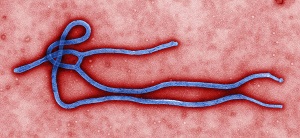 |
| Ebola virus under an electron microscope--Courtesy of CDC |
An individual's genetic makeup may be the difference between life and death in patients exposed to the deadly Ebola virus, according to new research.
Using a new mouse model, researchers at the University of Washington, National Institutes of Health's Rocky Mountain Laboratories in Montana and the University of North Carolina at Chapel Hill found that genetics is likely the reason sufferers experience such varying reactions to Ebola virus, which range from mild to lethal.
Ebola research and drug discovery has stalled in part because of a lack of an Ebola mouse model that accurately replicates the main characteristics of human Ebola hemorrhagic fever.
The research team infected their engineered mice with a rodent form of the same species of ebolavirus responsible for the current West Africa outbreak. Following infection, 19% of the mice showed no signs of the virus except weight loss and survived exposure. Two weeks later, this group of mice regained the lost weight and had normal-looking livers. Another group of mice, making up 11% in the study, were partially resistant and less than half of these died.
The largest group of mice--70%--had a more than 50% mortality rate with varying symptoms of Ebola, including blood that took too long to clot, internal bleeding, swollen spleens and changes in liver color and texture.
In contrast, conventional laboratory mice previously infected with the virus died but did not develop any of these characteristic symptoms of Ebola hemorrhagic fever.
The investigators found that specific genetic lines of mice correlated to different disease outcomes. This could explain the wide variety of human responses to Ebola in the current West African outbreak. The findings were published in the journal Science.
- get the study abstract from Science
- read the press release